Edie Melson's Blog, page 200
May 18, 2020
Staying S.T.R.O.N.G. as a Writer
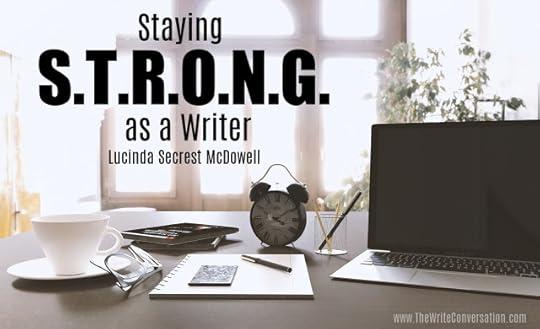
by Lucinda Secrest McDowell @LucindaSMcDowel
How has the pandemic and quarantine affected your life as a writer and speaker? I can imagine some of your answers because they are probably similar to some of mine: cancellations, uncertainty, inertia, and trying out new ways of communicating. Everything that exacerbates our weakness, not our strength.Things are changing constantly during this world health crisis and no matter what our profession, we are going to have to stay flexible and make wise choices. To acknowledge hard truths and still live vibrantly in our new normal. We go deeper than just surface responses – we garner strength of soul within to help us face the challenges without.
Here are some ways I’m seeking to Stay Strong as a Writer:S – Surrender Your Plans. “Give all your worries and cares to God, for He cares about you.” 1 Peter 5.7
This is not the life you signed up for, but it’s the life you have right now. As many things get smaller (event opportunities, activities, finances) or non-existent, it won’t help to feed fears. Instead, try to hold all loosely – your professional plans, your loved ones, your need-to-control. Try this simple exercise: Open your hands to release all that to God by naming each one, “Lord, I release _______ to You.” Then, keep your hands open to receive what God will give in return, “Lord, I receive Your gift of _________.”
T – Trust God’s Presence, Peace, and Power. “For I hold you by the right hand – I, the Lord your God. And I say to you, ‘Don’t be afraid. I am here to help you.’” Isaiah 41.13
God is the Creator and Sustainer of the universe who loves you more than you can possibly imagine. He is not wringing his hands in despair. He is, in fact, present through His Spirit – and nothing is impossible for Him. Can you say with King David, “When I am afraid, I will put my trust in You?” (Psalm 56.3) In the Bible God promises each of us His presence, peace, and power. You are not alone! Use this enforced withdrawal time to be in His presence more, filling up with His power and peace that you will eventually share with others in remarkable ways.
R – Reach Out with Kindness. “Be kind and compassionate to one another.” Ephesians 4.32
Tight spaces, deprivation, and anxiety can easily lead to bad tempers and self-centeredness. The perfect antidote is to make a deliberate choice to extend kindness to those in your household and community. Offer some writing or speaking services online as a free gift – just to serve others and make new connections. Think outside the box of how to show compassion to the servers and the suffering. Your light in the darkness will encourage, provide practical help, and bring hope.
O – Observe a Daily Routine. “Let me hear of Your unfailing love each morning, for I am trusting You. Show me where to walk, for I give myself to You.” Psalm 143.8
Awaken each day, get dressed, and make your bed. This and other established routines will provide security and order to your household. Limit your intake of media and news. Use your most alert and creative time to at least write in your journal or brainstorm some new topics, or start researching something you’ve never had time to pursue. Who knows what might come of those planted seeds – even a book or new retreat series? Plan exercise, meals, reading, rest, chores, schooling, daily check-in phone calls, and projects. Hugs and listening to your children will go a long way to help them know you are their ‘safe place.’ How you handle this crisis may well be your last and greatest legacy.
N – Nurture Your Inner Life. “Guard your heart above all else, for it determines the course of your life.” Proverbs 4.23
Take care of yourself – body and soul. Yes, do all the health mandates for physical safety. But also focus on your inner life through silence, prayers, Bible study, worship, rest, journaling, and those creative activities that renew and refresh. In addition to my morning prayers, I also have a hot cup of fresh brewed tea every afternoon with a favorite devotional book. Fill up your soul with deposits of that which is “true, honorable, lovely, pure, right, admirable, excellent, and worthy of praise.” (Philippians 4) Your strength of soul will then overflow to others. Please be okay with no writing productivity if that’s how your life is right now because you are sick, caring for others, or just too distracted. God is present at all times and in all seasons.
G – Give Thanks Daily. “Let the peace of Christ rule in your hearts. And be thankful.” Colossians 3.15
No matter how bad life gets, there are always blessings. Look for the gifts you have. Name them. Rather than complaining about not hearing from publishers on that book proposal, why not start blogging again? Make a gratitude list each day and then offer up thanks to the God who provides. Be generous to others. Say “Thank You” to those who rarely hear it and pray for them. And then, embrace the peace that God promises to bring to your own heart and life.
I confess, I don’t feel very strong some days. And if someone else tells me that Shakespeare wrote his best plays during quarantine, I think I will scream! But, by God’s grace, I am determined to live vibrantly through these unknown and unprecedented times as a soul strong woman. This is my prayer for you as well.
TWEETABLEStaying S.T.R.O.N.G. as a Writer - encouragement from @LucindaSMcDowel on @EdieMelson (Click to Tweet)
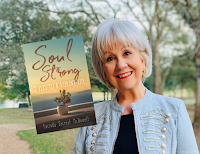 Lucinda Secrest McDowell, M.T.S., is a storyteller and seasoned mentor who engages both heart and mind while
“Helping you Choose a Life of Serenity & Strength.”
A graduate of Gordon-Conwell Theological Seminary and Furman University, McDowell is the author of 15 books and contributing author to 30+ books. Her award-winning books include
LIFE-GIVING CHOICES
,
SOUL STRONG
(2020),
DWELLING PLACES
(2017 Christian Retailing BEST Award for Devotional),
ORDINARY GRACES
(2018 Selah Finalist),
LIVE THESE WORDS
, and
Refresh!
Lucinda, a member of the REDBUD WRITERS GUILD, received Mt. Hermon “Writer of the Year” award and guest blogs for The Write Conversation, Blue Ridge Mountains Christian Writers Conference Blog and (in)courage. Whether co-directing
“RENEW ~ RETREAT FOR NEW ENGLAND WRITING,”
pouring into young mamas, or leading a restorative day of prayer, she is energized by investing in people of all ages. Lucinda’s favorites include tea parties, good books, laughing friends, ancient prayers, country music, cozy quilts, musical theatre, and especially her family scattered around the world doing amazing things. Known for her ability to convey deep truth in practical and winsome ways, she writes from “Sunnyside” cottage in New England and blogs weekly at
https://lucindasecrestmcdowell.com/
Follow Lucinda on Twitter: @LUCINDASMCDOWEL
Lucinda Secrest McDowell, M.T.S., is a storyteller and seasoned mentor who engages both heart and mind while
“Helping you Choose a Life of Serenity & Strength.”
A graduate of Gordon-Conwell Theological Seminary and Furman University, McDowell is the author of 15 books and contributing author to 30+ books. Her award-winning books include
LIFE-GIVING CHOICES
,
SOUL STRONG
(2020),
DWELLING PLACES
(2017 Christian Retailing BEST Award for Devotional),
ORDINARY GRACES
(2018 Selah Finalist),
LIVE THESE WORDS
, and
Refresh!
Lucinda, a member of the REDBUD WRITERS GUILD, received Mt. Hermon “Writer of the Year” award and guest blogs for The Write Conversation, Blue Ridge Mountains Christian Writers Conference Blog and (in)courage. Whether co-directing
“RENEW ~ RETREAT FOR NEW ENGLAND WRITING,”
pouring into young mamas, or leading a restorative day of prayer, she is energized by investing in people of all ages. Lucinda’s favorites include tea parties, good books, laughing friends, ancient prayers, country music, cozy quilts, musical theatre, and especially her family scattered around the world doing amazing things. Known for her ability to convey deep truth in practical and winsome ways, she writes from “Sunnyside” cottage in New England and blogs weekly at
https://lucindasecrestmcdowell.com/
Follow Lucinda on Twitter: @LUCINDASMCDOWEL
Published on May 18, 2020 22:00
May 17, 2020
Tips for Recycling Marketing Content

by Karen Whiting @KarenHWhiting
Reuse, repurpose, and recycle should be good words when we think of our marketing. Once we generate words and/or images we want to get the most out of them. When we are in the same genre, or a series, it’s even easier to tweak and reuse material. You can repurpose your own words or grab words from a review to repurpose.Recycling saves time as we don’t have to start from scratch. Repurposing lets us use a main point to create something re-fashioned for a different audience. Re-formating a meme to post your work to another social media. Consider the many ways to use what you already created for to get more marketing mileage from your work.
Articles and Blog PostsUse an article to create talking points and sales points for creating memes, bookmarks, and tip sheets. Use the research material, especially what did not fit into the published article, to create new articles.
Observe your blog posts that get more hits and comments. Since these are popular and you own the rights, use them in a few ways. Turn the blog into an article. Take the comment and questions to come up with new blog posts. From comments figure out what readers found most helpful and use that for a tip sheet to give away. Use the best of the tips to create memes.
MemesFor your most popular memes, change out the text. This works great if you have a series of tips and want to post one a day. Use the memes with the tips for a PPT presentation that you can also turn into a video with a voice over or music to post on social media, you tube channel, or your web site.
Tweak memes from presentations for new events by changing location, time, and date. If you make a generic one for interviews you can save one spot to add in the station’s logo and change the link in the text section.
Reformat memes to fit other social media platforms since the sizing and shape are not always the same. Be sure to add all your images to Pinterest and include links to blog post that use the images.
Swag and Other Give-awaysConsider how to use a basic swag idea again, especially if you have left over supplies. If you create bookmarks with charms, you can change the charm to match the new book and change out the book cover and description. The rest about you can remain the same. I change up a basic puppet craft with a new face to match an animal from one of the stories in a new devotional for families or children.
Another friend used little vials to add in a mustard seed and scroll of paper for prayer need. She speaks at women’s conferences and could also use extra vials to add in a ruby for a woman’s conference to remind women of their great value.
Another friend did one top ten list and that became a regular type giveaway with a different top 10 list for each book. Those can also be made into bookmarks or used as talking points for articles.
Reviews and interviewsUse reviews posted to create new marketing. Excerpt words from reviews and interviews to use on a meme about the book or in a press release. Again, if you create a generic meme for the book it’s just a text change.
Post links to the reviews and interviews that you can reuse at other times. Excerpt the intro or a good quote from the interview that speaks about you as an author that can be used to help introduce your new book or add into a press release.
Listen or read the interviews and find the hot topics and ideas that you can excerpt or use as new talking points for new blogs and articles. Let the questions asked be the start of a blog post, or the answer be new text on a meme.
Curate InformationOrganize your materials as part of recycling. Sort videos into playlists or groups. Gather articles or blog posts on the same topic together for a booklet or an outline for speaking at a weekend retreat. This could be to sell or give away to followers. Gather tip sheets on the same topic and use them as the basic building blocks to create a series of articles or columns.
You already have a treasure of marketing gems. Simply dig through file folders of your book’s marketing materials and you’ll find plenty of nuggets to share with readers. It’s a win-win situation.
TWEETABLETips for Recycling Marketing Content - @KarenHWhiting on @EdieMelson (Click to Tweet)
 Karen Whiting (www.karenwhiting.com) is an international speaker, former television host of Puppets on Parade, certified writing and marketing coach, and award-winning author of twenty-six books for women, children, and families. Her newest book, 52 Weekly Devotions for Families Called to Serve, uses stories, activities, and chat prompts to help families develop servant hearts and foster strong bonds in families who have members serving the community, nation, or world.
Karen Whiting (www.karenwhiting.com) is an international speaker, former television host of Puppets on Parade, certified writing and marketing coach, and award-winning author of twenty-six books for women, children, and families. Her newest book, 52 Weekly Devotions for Families Called to Serve, uses stories, activities, and chat prompts to help families develop servant hearts and foster strong bonds in families who have members serving the community, nation, or world.She has a heart to grow tomorrow’s wholesome families today. She has written more than seven hundred articles for more than sixty publications and loves to let creativity splash over the pages of what she writes. She writes for Leading Hearts and Crosswalk.com. Connect with Karen on Twitter @KarenHWhiting, Pinterest KarenWhiting, and FB KarenHWhiting
Published on May 17, 2020 22:00
May 16, 2020
Chop that Writer’s Block

by Tammy Karasek @TickledPinkTam
I’ve read several articles recently on the issue of Writer’s Block. It’s a thing. It’s not a thing.
Well, is it a thing or not? Seems to me since so many folks are writing about it, it’s just gotta be a thing, right?I believe it is, because I’ve obviously caught it. Like a cold virus, this thing has enveloped me into a suffocating paralysis unable to breath because of its squeeze. The more I think about not having any word count done, the more I stress and the tighter the squeeze. One would think with our current situation of staying home, there would be plenty of time to get writing completed. Apparently I’m not the only writer that is dealing with this due to other writer’s sharing their angst about not able to sit down and write currently.
I was determined to figure out the reason for my writer’s block and I noticed several reasons: Most of my writer’s block is me blocking the act of writing.I haven’t placed a priority on writing and written it in that blank 2020 planner.I haven’t given myself deadlines or goals to reach.I’ve let things—anything—grab my attention when I should be … “hey look, squirrel”.I’ve picked up another virus, besides the cold, of I’ll do it tomorrow-itis.
Once I saw what was pulling me away from actual writing time, I decided to make a plan of attack. Since I often carry my phone with me wherever I go, I came up with an idea that is starting to help with that block. I realized that without my normal routine, it became easier to put off until tomorrow that which I should get done today.
Since I sit down daily to my computer in the morning, I now pull out my planner first. That cool new planner I was so excited to use this year … until Covid changed that. Without having to add appointments and meet-ups, the planner had remained on the shelf behind the desk. Now, I look over the day’s items to be done, plan for them and get going.
When I hit a writing block, I look at the planner. I keep a post it note that moves from day to day of house projects I’d love to get finished and unclutter my mind of. I’ll pick one, grab my phone and head off to the project.
As an example, the other day I knew I needed to mask up and go to the grocery store. It’s been a while and the time had come to go. I barely got out of my neighborhood and a scene erupted like a shaken can of pop when opened. Sure, now that I’m not at my computer. But I have my phone with me.
At the next red light, I pulled out my phone, opened voice memos and rattled off the idea for the scene. I can certainly talk faster than write. At the store, it hits again. I rattled off another idea into my phone. Nobody around me knew if I was talking to myself, they’re doing their best to shop and skedaddle out of there themselves. If they do hear you talking to yourself, then they are closer than the six-foot allotted to them between shoppers.
Groceries done, I headed home all pleased with myself that I’ve productively completed two things on my to do list. Groceries and a scene or two for my WIP.
That’s what I’ve been doing during this odd time of our lives in order to keep my words flowing. If you have been struggling to write, might I suggest you try something different than your usual writing routine? My idea of the phone is one of the ways I’m trying to change it up for myself.
Maybe you could try writing your ideas/scenes out in longhand sitting in your car in a grocery store parking lot. It’s not quite a coffee shop, but people watching often spurs on ideas to use in your writing piece.
TWEETABLEChop that Writer’s Block - Tammy Karasek, @TickledPinkTam on @EdieMelson (Click to Tweet)
 You’ll find Tammy seeing humor and causing laughter in every aspect of life. Her past, filled with bullying and criticism from family, is the driving force of her passion to always encourage others and give them The Reason to smile. She’s been married to her college sweetheart, Larry, for 37 years, a mom to their grown daughter, Kristen, and wrapped around the paw of a little dog named Hattie. Born and raised in Ohio, her family now resides in South Carolina. She is the President of Word Weavers Upstate SC, member of ACFW and My Book Therapy/Novel Academy. She’s the Blog Editor for Word Weavers International. A Conference Assistant for Blue Ridge Christian Writers Conference. A monthly contributor for The Write Conversation. A contributor in the 2018 Divine Moments Compilation Book—Cool-inary Moments. Also a regular contributor to several other blogs.
You’ll find Tammy seeing humor and causing laughter in every aspect of life. Her past, filled with bullying and criticism from family, is the driving force of her passion to always encourage others and give them The Reason to smile. She’s been married to her college sweetheart, Larry, for 37 years, a mom to their grown daughter, Kristen, and wrapped around the paw of a little dog named Hattie. Born and raised in Ohio, her family now resides in South Carolina. She is the President of Word Weavers Upstate SC, member of ACFW and My Book Therapy/Novel Academy. She’s the Blog Editor for Word Weavers International. A Conference Assistant for Blue Ridge Christian Writers Conference. A monthly contributor for The Write Conversation. A contributor in the 2018 Divine Moments Compilation Book—Cool-inary Moments. Also a regular contributor to several other blogs. Connect with Tammy: Blog: http://www.tammykarasek.com Email: tickledpinktammy@gmail.com
Published on May 16, 2020 22:00
May 15, 2020
Facing Writing Non-Productivity Without the Guilt
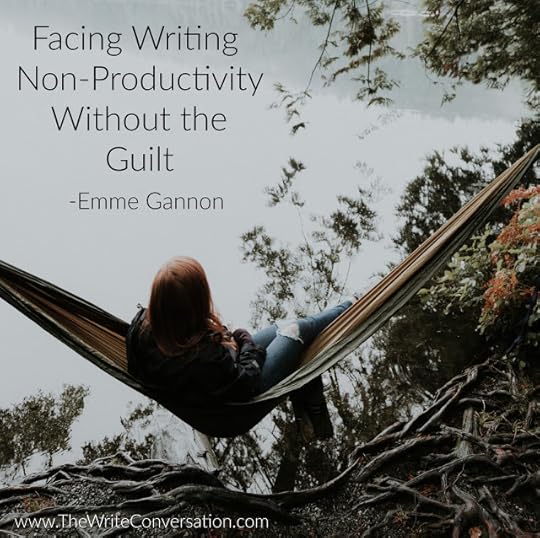
by Emme Gannon @GannonEmme
We’ve experienced almost two months of lock down—government mandated boundaries that includes staying at home except for securing necessities. Since I wander around my house and garden alone these days, my thoughts and imaginations often suddenly explode like fireworks on the fourth of July. They come out of nowhere with uncanny clarity. The memories take on new life when looking back from the pivotal point of living in a pandemic with an unseen enemy.One such tender memory recently rushed at me as I was planting flowers in a large pot on my patio. The touch of the moist earth in my bare hands stole me away to a long ago vacation with my husband. Each morning we would walk the beach, holding hands and feeling the warmth of the sun on our backs. We had very little conversation as we each marveled at the shared experience. I remember how his hand felt as it held tight to mine—the sense of protection his grasp evoked. The sound of the waves crashing the shore while the mewing call of the gulls overhead all contributed to a symphony of joy and contentment with the one I love.
As we rounded the curve we came upon a young man who clearly defined multi-tasking. He stood facing the roar of the ocean, one hand holding a fishing rod, the other hand held a cell phone to his ear. On his back was a baby tucked into a back pack, his tiny legs thrashing about with joy at the closeness to his father and the wonder of the sea, all lost to his dad.
My husband and I broke our silence to mourn the sacred moments the dad was missing by trying to pour all of life into one moment. He missed seeing his child’s reaction to the rhythm of the tides. He missed seeing his little feet dance with excitement at this new experience.
Now that my husband is with the Lord, I relive more and more memories, where nothing was said but everything felt—the moments where the awe of God and one another reigned supreme in our hearts, adding more cement to our already strong marriage.
If we learn just one thing from being sequestered at home, I hope it will be the sacredness of solitude. Our lives are meant to be God’s love story written by Jesus. Instead, our urgency to produce often slides us by the truly deep and lasting moments of life—those moments that bring a deeper dimension and truth to who we are and what we write.
Endless motion produces scattered thoughts and culminates in scattered dreams. Let this forced isolation become an inward pilgrimage of quiet introspection, where memories and life lived are reflected with a depth that comes from hearing God speak. We can all come out from this wiser and stronger because God has much to say to our hungry soul. Wisdom that we’ve often been too busy to hear.
TWEETABLE
Facing Writing Non-Productivity Without the Guilt - @GannonEmme on @EdieMelson (Click to Tweet)
 Emme Gannon is a wife, mother, and grandmother who loves to write stories that stir the heart. Her award-winning writing has appeared in Focus on the Family magazine, several anthologies, and numerous newsletters. She just completed her first novel.
Emme Gannon is a wife, mother, and grandmother who loves to write stories that stir the heart. Her award-winning writing has appeared in Focus on the Family magazine, several anthologies, and numerous newsletters. She just completed her first novel.
Published on May 15, 2020 22:00
May 14, 2020
5 Things I Love Most About Blogging

by Edie Melson @EdieMelson
First, I want to thank you all for being such a loyal community. Back in early December, I asked for a special Christmas present. And boy oh boy did you all respond!
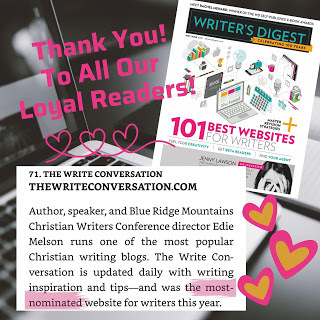 I asked if you’d be willing to nominate The Write Conversation as one of the Writer’s Digest Top 101 Sites for Writers. And it worked. Once again, we are on the list. But beyond that, in the description of TWC the editor notes that this site was the MOST NOMINATED of any site this year.
I asked if you’d be willing to nominate The Write Conversation as one of the Writer’s Digest Top 101 Sites for Writers. And it worked. Once again, we are on the list. But beyond that, in the description of TWC the editor notes that this site was the MOST NOMINATED of any site this year. To say I’m humbled is the grossest understatement.
Thank you all from the bottom of my heart!
So today I want to share with you My Favorite Things About Blogging
1. The Community that Grows Around a Blog. This is my most favorite part of blogging. Many of you I’ve never met in person, but I know we’re friends. I look forward to your comments, your questions and the encouragement you give each other.
2. The Discipline I’ve Developed. Blogging is work—fun work—but still work. When someone starts a blog they are entering into a contract and commitment with the readers. There are days when it’s hard to write or post a blog, but by following through I’ve found discipline that helps in every aspect of my life.
3. The Ideas that Appear. When I first began this blog I had dozens of ideas, but as time flew by, I went through my first dry spell. It taught me to see ideas everywhere. I began collecting them like my kids once collected baseball cards. The more ideas began to pop up, the more I developed an eye to find them.
4. The Things I’ve Learned. One thing I’ll say is that you all are amazing. I learn so much through the ideas and suggestions you share in the comments of the blog posts. I also have to do research when you come up with a question that stumps me. Truthfully I feel like I’m cheating because I get so much from writing this blog.
5. Watching God Work. Many of you have shared ways that God has worked and is working in your lives. I get to see how God is busy in the world by peeping into your lives.
These are the things I love most about blogging. I’d love to know what you love about reading blogs AND about writing your own blog posts. Be sure to leave your thoughts in the comments section below!
Don’t forget to join the conversation!Blessings, Edie
TWEETABLE5 Things I Love Most About Blogging - @EdieMelson (Click to Tweet)
 Edie Melson is a woman of faith with ink-stained fingers observing life through the lens of her camera. No matter whether she’s talking to writers, entrepreneurs, or readers, her first advice is always “Find your voice, live your story.” As an author, blogger, and speaker she’s encouraged and challenged audiences across the country and around the world. Her numerous books reflect her passion to help others develop the strength of their God-given gifts and apply them to their lives.Connect with her on her website, through Facebook, Twitter and on Instagram.
Edie Melson is a woman of faith with ink-stained fingers observing life through the lens of her camera. No matter whether she’s talking to writers, entrepreneurs, or readers, her first advice is always “Find your voice, live your story.” As an author, blogger, and speaker she’s encouraged and challenged audiences across the country and around the world. Her numerous books reflect her passion to help others develop the strength of their God-given gifts and apply them to their lives.Connect with her on her website, through Facebook, Twitter and on Instagram.
Published on May 14, 2020 22:00
20 Newspaper Writing Tips for ‘20

by Julie Lavender @JLavenderWrites
Looking for new or additional writing credits? Have you thought about writing for the local newspaper? I’ve shared tips for newspaper writing before, and I hope I’ve convinced some of you to tap into that market.
Let’s review 20 newspaper writing tips for ‘20 and analyze an article as we go.
1. Make sure the headline, which serves as the title of the newspaper article, is informative, yet also engaging and interesting, and typically between five to seven words. Here’s the headline of an article I wrote recently.Ogeechee Area Hospice receives a generous $800,000 donation
2. Sometimes, a headline is easier to write after the article is completely written.
3. The lede, the first sentence of the article, should be between 30 and 35 words that summarize the main points of the story. Ogeechee Area Hospice received a sizeable donation during its 25th anniversary celebration on Thursday evening that has already brought marked changes in the organization.
4. The lede covers the who, what, when, and where of a story. Sometimes, but not regularly, the lede will include the how and why of a story.
5. Follow the lede with paragraphs of supporting details, in compelling words that keep the reader’s attention until the very end of the article.“We are debt free now,” said Tinker Lanier, Ogeechee Area Hospice (OAH) Manager of Donor Relations. “The donation helped us pay off our mortgage and, as a non-profit, those [monthly payments] going forward can go towards our patients.”
6. Paragraphs are usually one to three sentences in length. Ted Tucker, on behalf of the Tucker Family, presented a check for $800,000 to OAH in honor of his parents, Susie Scott Tucker and Eddie Frank Tucker. Ted Tucker and his brother James, who was also in attendance of the event, are the surviving children of 11 from the marriage of the Scott and Tucker union.
7. Sentences are short and to the point and typically follow the subject-verb-object pattern. “Our parents valued education,” Tucker continued.
8. Cut unnecessary words. Instead of saying, “Police officers arrived quickly at the scene and were able to find the suspect on Main Street,” say, “Police officers located the suspect on Main Street.”
9. Avoid the use of excessive adjectives and adverbs.
10. Use simple words. Avoid complicated and flowery vocabulary.Tucker said that a neighbor co-signed an educational loan for him to attend college.
11. Use active verbs when possible and avoid passive sentences.Jean Bartels, OAH Board President, accepted the donation.
12. Write articles in third person. After the presentation, Tucker added that he was honored to have the opportunity to make the donation.
13. Newspaper articles are generally written in past tense.Tucker said that in a consult with his advisor, Tucker asked him to figure what he needed to live and then he wanted to give the rest away.
14. The first time you refer to a person in a story, use the full name and title, when applicable. Following the first mention, refer to the person by last name only. The exception occurs when two people with the same last name are discussed in a story. Use full names for each reference when that occurs. Tracy Joiner, owner of Joiner-Anderson Funeral Home & Crematory in Statesboro, introduced his Great Uncles Ted and James.
“My Grandmother, Lucille Joiner, was the oldest of the eleven, and my Great Uncle, Ted Tucker, the youngest,” said Joiner.
15. Long names of companies or businesses that also go by initials should be spelled out completely the first time, with the initials appearing in parentheses afterwards. Those initials may be used throughout the rest of the article for brevity.“We are debt free now,” said Tinker Lanier, Ogeechee Area Hospice (OAH) Manager of Donor Relations.
16. Unlike other literary works, don’t repeat information at the end of the article as a summary.
17. Conduct in-person interviews when possible and take copious notes, recording the interview if possible.
18. Counter-check facts and statistics and check spellings, especially names and titles.
19. Include pertinent, informative quotes and attribute quotes accurately. “We grew up in the Leefield community,” said Ted Tucker. “Our ma and daddy were sharecroppers. We were low on the socio-economic spectrum – it means you have no money.
“Raising a family of eleven kids is challenging. But, all eleven children became successful adults.”
Tucker attributed that success to a number of influences. He said, “We were raised in a Christian household. We went to church at least three times a week, twice on Sunday and prayer meeting during the week.
20. Conclude the article with a pertinent quote, related link, invitation or call to action, or powerful statement. OAH plans to unveil a plaque for Susie Scott Tucker and Eddie Frank Tucker on Saturday at 1:00PM on the facility’s grounds and the public is invited to attend.
TWEETABLE20 Newspaper Writing Tips for '20 - @JLavenderWrites on @EdieMelson (Click to Tweet)
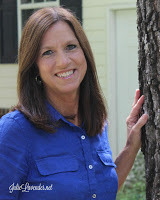 Julie Lavender is a journalist, author, and former homeschooling mom of twenty-five years who holds a Masters Degree in Early Childhood Education. Julie is married to her high-school and college sweetheart, and Julie and David are the parents of four, in-law of one, and grandparents to a sweet, fourteen-month-old grandson. Julie loved living in various locations across the country as the wife of a medical entomologist for the United States Navy. After her husband retired from active duty, the family moved back to their hometown, and David began work as a wildlife biologist at a nearby Army installation.
Julie Lavender is a journalist, author, and former homeschooling mom of twenty-five years who holds a Masters Degree in Early Childhood Education. Julie is married to her high-school and college sweetheart, and Julie and David are the parents of four, in-law of one, and grandparents to a sweet, fourteen-month-old grandson. Julie loved living in various locations across the country as the wife of a medical entomologist for the United States Navy. After her husband retired from active duty, the family moved back to their hometown, and David began work as a wildlife biologist at a nearby Army installation.Julie is excited that her parenting book, 365 Ways to Love Your Child: Turning Little Moments into Lasting Memories, published by Revell, releases in October of this year. Julie’s newspaper contributions number over 900 news articles, features, columns, and more, and she loves sharing good news and the Good News in her newspaper, the Statesboro Herald. She would love for you to connect with her on social media and chat about newspaper writing.
Published on May 14, 2020 06:54
May 12, 2020
Pandemic Writing Opportunities

by Linda Gilden @LindaGilden
Many people are a bit frustrated about having to stay at home during the pandemic. They are suffering from loss of income, socialization withdrawal, and not happy that others are deciding whether or not they can go to the store.
But as a writer, I feel like I have been given permission to stay home and do what I love. No one is asking me out to lunch and I can’t go out to interview a source for an article. So I can just stay home and write articles. For the last few weeks of the sheltering-at-home time, I have had more article assignments than I have in a long time.“How is that possible?” you ask.
If you are at home and looking for work, don’t just look at all the obvious places. Be creative and you will be able to stay busy while you are at home. And if you have never written articles, now is a good time to start.
6 Writing Opportunities During the Pandemic1. Reconnect with publications you have worked with before. Most of the staff is working from home and able to respond quickly. Contact the editor and let him or her know that you have some time in your writing calendar and would be glad to do an article on assignment. If you have a good idea for an article for that publication, pitch it to them at that time.2. Visit job boards. Many writer websites have job boards for writers and post writing jobs several days each week. Use your computer to search for writing jobs and assignments. Visit LinkedIn and see what you can find there. Craigslist also posts writing jobs occasionally.3. Contact blogs you read regularly to find out if they use guest bloggers. Look at blogs on your topic of interest and contact them to find out if you could write for them. Quite a few blogs even pay their guest bloggers.4. Much of the news for the last few months has been about the corona virus. Pitch a topic that will help people ease back into their normal schedules safely. 5. Did you learn something new during your days of sheltering-at-home that you are going to be able to use from now on. Write a how to use this new skill in the future.6. Do you have a book? Write an article that will expand the reach of your book. Put a note about your article on Facebook. Lots of people are reading who don’t usually have time!In just the time it took for me to write this blog, I received two lists of writing opportunities and one blog request in my inbox. I didn’t even have to go look for those. But had I not received them, I would have visited some of the sights above.
What are you writing today? Are you staring at your computer waiting for inspiration? Don’t waste any more time. Reach out to magazines, blogs, and publishers. You have a lot to offer. Don’t wait until they come looking for you!
TWEETABLEPandemic Writing Opportunities - @LindaGilden on @EdieMelson (Click to Tweet)
 Linda Gilden is an award-winning writer, speaker, editor, certified writing and speaking coach, and personality consultant. Linda is the author of 19 books and over 1000 magazine articles. She enjoys every meeting with editors and knowing we are all part of the same team. Linda’s favorite activity (other than eating folded potato chips) is floating in a pool with a good book surrounded by splashing grandchildren—a great source of writing material! www.lindagilden.com
Linda Gilden is an award-winning writer, speaker, editor, certified writing and speaking coach, and personality consultant. Linda is the author of 19 books and over 1000 magazine articles. She enjoys every meeting with editors and knowing we are all part of the same team. Linda’s favorite activity (other than eating folded potato chips) is floating in a pool with a good book surrounded by splashing grandchildren—a great source of writing material! www.lindagilden.com
Published on May 12, 2020 22:00
May 11, 2020
What Makes a Writer?

by Cindy Sproles @CindyDevoted
The joy found in helping new authors is fulfilling. It brings a smile to my face when I find a writer who has a burning desire to learn. I met such a man after he contacted me with the news he’d read my novel. He told me he was making the transition from writing non-fiction to fiction and he had a novel in the works.
It was obvious Daniel had talent. The question would be, did the talent belong to a person with a willing heart? I pondered a while then sent a note and asked if he had an open mind. He did and so over the next week, we worked together picking apart that first chapter. I gave him books to read, power points, information on writing fiction and as quickly as I sent it to him, he devoured it, returning rewritten work the next day. Daniel wanted to learn to write fiction. As much as it pained him to let go of some of the descriptions, he saw the importance of the story and daily he pounded out, refined, and rewrote the entire story.
What is my point?
Lots of writers do this daily. What was different about this man? His desire to tell the story overrode the desire to be a published writer and he was willing to sacrifice what he’d done to make it right.
The call to be a writer entails more than simply writing to write a story. My first conference, I sat in a class with Len Goss from Broadman & Holman Publishing. I wrote down his first two lines to the class. “Everybody has a story. What makes you think yours is publishable?”
Not only was that a shock to my dreams of being a writer but it was one of the most valuable things I’ve ever heard. Everybody has a story. What makes me think mine is any better than the next? From that point on, Goss talked about learning to submit to the rules of the craft and the industry. It was a hard class to sit through because I, like many other brand new writers, thought publishing would be simple. I thought once I wrote my story, it was done and I didn’t understand the craft. I saw that day, there was a lot to being a writer and it must begin in my heart.
I learned three very valuable things from that class I’d like to share with you.
Have the right heart Who would have thought writing required having the right heart, but it does. When you have the heart to learn and the willingness to listen, then you’ve taken the first step to publication. To be a good writer you must be willing to be teachable and that truly is a “heart” thing. Many first-time writers come into conferences believing they have it all. They assume their story is perfect and when they meet with rejection, they grow angry. I sat at a conference with a woman who insisted her story was going to be published and if I didn’t want it, she’d just pay to have it published because that was the easiest way anyway.
When I asked her why she thought to publish it herself was easier, she replied emphatically that “they” would sell the book and it would be on Amazon. Though I never found out who “they” was it was clear she had no desire to listen to suggestions or experience. She didn’t have the right heart and though she could easily self-publish a book, she had no desire to understand or learn what it entailed. Her only desire was a published book.
HINT: Just because a book is listed on Amazon does not mean it will sell. According to Amazon, there are 32.8 million books listed on their site. Amazon does not sell your book for you. They are a distributor who the average Joe can purchase single quantities from rather than in bulk. Someone has to take the initiative to sell the book and in the case of someone who publishes on their own—they become the sole seller.
Seeking guidance and trainingAnother point Goss made was, as a new writer, we were doing exactly what we should be doing. Learning. There are tons of books on the craft of writing and you can learn amazing things from books like Story Trumps Structure by Steven James or Plot and Structure by James Scott Bell or the oldie but goodie, Stein on Writing by Sol Stein, but there is nothing any better than sitting at the feet of experienced authors who have successfully muddled the publishing maze and learned the ways to craft tighter, better stories. Seek guidance and training. Just do it.
Conferences are the perfect place to do that. Many successful authors are launching mentoring sites where you can purchase their expertise and receive one-on-one guidance. This is valuable. On a personal note, I remember sitting at that same first conference watching Eva Marie Everson, Ann Tatlock, Alton Gansky, and Yvonne Lehman wishing I could just be their friend, learn from them—and because of networking at conferences and attending their classes, I can now call them all valuable, close friends and mentors. Once again, seek guidance and training.
Persistence pays offThose who continue to pursue the dream, work to learn, and refine eventually find publication. It is important to remember the words of Alton Gansky, “Your book may not be meant to sit on the shelves of a bookstore, but they may only be meant for the guy sitting next to you.” The truth is, if you keep at it, you will find success in your writing, in the growth from your writing and in the opportunities that arise which you never expected.
As for Daniel…his book is now published because he was willing to do the necessary work it took to make the book successful. That first class by Len Goss was hard to swallow as a new conferee and writer, but looking back it was, bar none, the most valuable class I’ve ever taken.
What makes a writer? Practice, practice, practice.
*Check out Daniel Overdorf’s book A Death Well Lived
TWEETABLEWhat Makes a Writer? Thoughts from @CindyDevoted on @EdieMelson (Click to Tweet)
 Cindy K. Sproles is an author, speaker, and conference teacher. She is the cofounder of ChristianDevotions.us and the executive editor of ChristianDevotions.us and InspireaFire.com. Cindy is the managing editor for Straight Street Books and SonRise Devotionals, both imprints of Lighthouse Publishing of the Carolinas. She is an award-winning and best-selling author and the director of the Asheville Christian Writers Conference. Visit Cindy at www.cindysproles.com. @cindydevoted
Cindy K. Sproles is an author, speaker, and conference teacher. She is the cofounder of ChristianDevotions.us and the executive editor of ChristianDevotions.us and InspireaFire.com. Cindy is the managing editor for Straight Street Books and SonRise Devotionals, both imprints of Lighthouse Publishing of the Carolinas. She is an award-winning and best-selling author and the director of the Asheville Christian Writers Conference. Visit Cindy at www.cindysproles.com. @cindydevoted
Published on May 11, 2020 22:00
May 10, 2020
4 Takeaways from a Book for Authors Who are Called to Speak
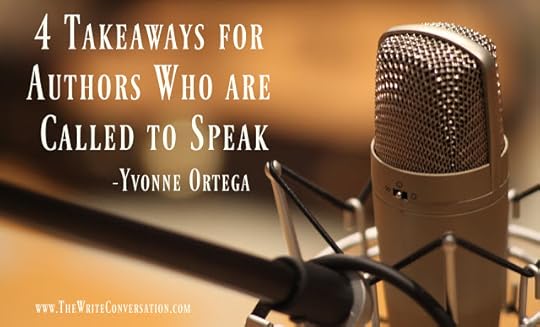
by Yvonne Ortega @YvonneOrtega1
I read Called to Speak from cover to cover almost non-stop. The authors Edna Ellison and Linda J. Gilden stirred my existing passion for speaking.
If you’re a writer who speaks, you will welcome the help from Ellison and Gilden. Whether you present before a general market or a faith-based audience, this book makes a great addition to your library of resources.First, Called to Speak addresses the spiritual side of speaking.In many speaker trainings and refresher events, attendees receive content and delivery tips. We need them. However, as Christians, we require the spiritual side as well.
The authors cover passion and purpose in speaking from a Christian perspective. They address our need to focus on Jesus Christ, the power of prayer, and spiritual warfare. The chapters include Biblical examples to enrich their points.
As a speaker, I’ve learned the hard way that my focus on Jesus Christ determines my success or failure. The enemy of our souls steps up the hindrances to our work as we prepare to speak. Prayer becomes a lifeline. This book confirms my experience with examples and a checklist for the reader.
Second, Called to Speak also addresses communication and the process.I appreciate Ellison and Gilden’s emphasis on speaking to impact people. Add to that their tips to ensure the audience receives our message.
Two of my presentations in progress are on life after divorce. I must answer the question, “What’s in it for the audience?” The authors remind me and you that our speaking should inspire the audience to change for the better and meet their needs.
In the chapter on process and presentation, we can go from research and an outline to the introduction, middle, and conclusion with attention to delivery techniques.
Third, Called to Speak covers relationships and publicity.We may not have thought of all the possible relationships involved in speaking, but many exist, from God and the professional speakers to the planners and other workers at the event. Ellison and Gilden also include the pros and cons of those relationships.
As an example, at speaking events, I’ve had to work not only with the event planner and the photographer but also with the sound man and the greeter at the door.
The book includes a chapter on the personalities. It looks at the personalities of the speakers and of the people in the audience. The authors remind us to meet the needs of our audience based on their personalities.
Fourth, Called to Speak includes an appendix of practical resources.In the appendix, we can find a preparation plan, a speaker’s contract, and tips for a speaker’s press kit and one-sheet. We can discover other treasures, too: a speaker’s travel checklist, a preparation plan, and advice on troubleshooting.
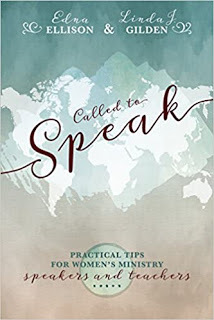 In summary, I highly recommend
Called to Speak
because it:addresses the spiritual side of speakingalso addresses communication and processcovers relationships and publicityincludes an appendix of practical resources
In summary, I highly recommend
Called to Speak
because it:addresses the spiritual side of speakingalso addresses communication and processcovers relationships and publicityincludes an appendix of practical resourcesPublisher: New Hope PublishersCopyright: January 2, 2017Paperback copy available at: lindagilden.com and online storesKindle version available at: amazon.com
TWEETABLE
4 Takeaways from a Book for Authors Who are Called to Speak - @YvonneOrtega1 on @EdieMelson (Click to Tweet)
 Yvonne Ortega walks with a small footprint but leaves a giant imprint in people’s lives. This power-packed package is a professional speaker and the author of the Moving from Broken to Beautiful® Series through cancer, divorce, forgiveness, and loss. Learn more at www.YvonneOrtega.com
Yvonne Ortega walks with a small footprint but leaves a giant imprint in people’s lives. This power-packed package is a professional speaker and the author of the Moving from Broken to Beautiful® Series through cancer, divorce, forgiveness, and loss. Learn more at www.YvonneOrtega.comYvonne speaks with honesty and humor as she shares her life and struggles through presentations that empower women to find peace, power, and purpose through God’s Word.
Yvonne’s background as a licensed professional counselor brings a unique perspective into the heart of women. She’s a speaking and writing coach and the owner of Moving from Broken to Beautiful®, LLC. She belongs to the Advanced Writers and Speakers Association, the Christian Authors Network, the National Speakers Association, and Toastmasters International.
She celebrates life at the beach, where she walks, builds sand castles, blows bubbles, and dances.
Published on May 10, 2020 22:00
May 9, 2020
When Fear Rules

by Martin Wiles @LinesFromGod
All around, I witnessed fear.
“I can’t find eggs for under four dollars a dozen, and I’m not gonna pay that,” one of my church members said as we talked on the phone. “Nor can I find any toilet paper.”
The Coronavirus pandemic has made people act in weird—even illogical—ways. Hoarding toilet paper is one of them. After a while, this practice became a joke and the topic of many Memes. I laughed as I looked at them…but not when I, like my friend, went to store after store and couldn’t find any toilet paper. Or when I had to get to the store as soon as they opened to purchase only one pack after stores put a limit on how many packs a customer could purchase. “Eggs are just over a dollar a dozen at Food Lion,” I told my friend, “and they do have toilet paper early in the morning.” He told me he wasn’t an early riser, so I knew why he couldn’t find any.
“Do you want us to bring you some when we come to church Sunday morning?” Even though we were only live streaming, we still went to the church building to record the sermon.
“Yes,” he said, relief in his voice. He was running low on toilet paper.
Early the next morning, my wife and I headed to the grocery store and made his purchases…and some of our own.
Not long after our conversation with this church member, another one texted my wife, “Could you see if you can find some bread-making flour and packs of yeast for me? The shelves here are empty.” She lived in the same small town as our other friend.
We added those items to the list, but when we went to the grocery store early that morning, we had no luck with her items. Seems she wasn’t the only one who had turned to making homemade bread since the shelves were often emptied of manufactured bread.
I’ve never experienced what the Coronavirus has done to people. Fear and anxiety rule. Worry follows. Stores can’t keep toilet paper on the shelves, even though diarrhea is not a symptom of Coronavirus. Other paper products disappeared as well. So did hand sanitizer, rubbing alcohol, and Clorox. Hoarders—even though they should have already had things hoarded—emerged from the woodwork and added to their stash. Meat disappeared from meat counters. Getting what we needed required early trips to the grocery store or multiple trips to several stores.
Listening to the news didn’t help. The President and his Coronavirus Task Force Team came on almost daily, reminding me of President Roosevelt’s Fireside Chats during the Great Depression. And weekly, the governor of my state gave local updates and changes.
Initially, I let the hoarders do the fearing and worrying, but the more I listened to the news, the more I felt fear creeping into my life. Scenes of people fighting over toilet paper didn’t help. Nor did seeing hundreds of people waiting at food pantries, hearing about the rising number of unemployed, or watching the military build field hospitals. Things that reminded me of war times. And we were in a war.
To top things off, the South witnessed a string of deadly April tornadoes—tornadoes that stayed on the ground for miles at a time, destroying homes and businesses and taking lives. Talking to my cousin, who’s a first responder, didn’t help. She told me about a little girl who had been impaled on a tree.
When fear rules, anxiety and worry aren’t far behind. But Paul tells us God hasn’t given those things. Rather, He sends a sound mind. “For God has not given us a spirit of fear, but of power and of love and of a sound mind” (2 Timothy 1:7 NKJV).
Fear comes in two varieties: the “I’m afraid of” type, and the “respect” type. The first is healthy if it relates to dangerous situations I’m trying to avoid or remove myself from. But if the things I fear are imaginary—things that might happen but haven’t—and those things control me, leading me to live in a constant state of fear, I then live in an unhealthy state of mind. The respect type of fear is good, especially as it relates to God. He has life and death power over me. I respect and love Him because He’s my God and has provided for my forgiveness.
When the right type of fear rules our life, we won’t worry, fear, or be anxious. God controls our tomorrows. He knows what we need, and just as He cares for His creation and creatures, He’ll care for us. When we trust Him with all situations and circumstances, He’ll remove our anxieties and give us a peace we can’t explain. On top of it all, He’ll give us a sound mind, which cannot co-exist with fear.
Letting the wrong kind of fear rule our life leads to hoarding, manipulating, killing, and all types of selfish acts. The right kind of fear leads us to selfless living where we trust God and love our neighbors.
Don’t let the wrong kind of fear rule your life.
TWEETABLEWhen Fear Rules - insight from Martin Wiles, @LinesFromGod on @EdieMelson (Click to Tweet)
 Martin Wiles is the founder of Love Lines from God (www.lovelinesfromgod.com) and serves as Managing Editor for Christian Devotions, Senior Editor for Inspire a Fire, and Proof Editor for Courier Publishing. He has authored six books and has been published in numerous publications. His most recent book, A Whisper in the Woods: Quiet Escapes in a Busy World, released in December 2019. He is a freelance editor, English teacher, author, and pastor.
Martin Wiles is the founder of Love Lines from God (www.lovelinesfromgod.com) and serves as Managing Editor for Christian Devotions, Senior Editor for Inspire a Fire, and Proof Editor for Courier Publishing. He has authored six books and has been published in numerous publications. His most recent book, A Whisper in the Woods: Quiet Escapes in a Busy World, released in December 2019. He is a freelance editor, English teacher, author, and pastor.
Published on May 09, 2020 22:00



